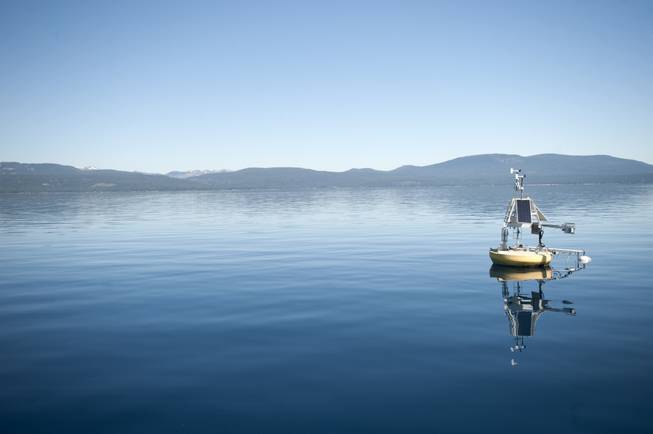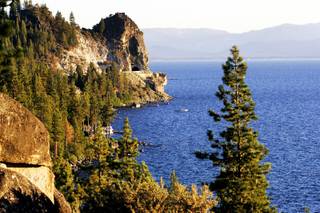
UC Davis / AP
This June 6, 2013, file photo released by University of California-Davis shows a monitoring station at Lake Tahoe, Calif.
Friday, Nov. 8, 2013 | 3 p.m.
INCLINE VILLAGE — For more than 40 years, scientists have carefully scrutinized the cobalt waters in the middle of Lake Tahoe, documenting a steady and disturbing decline in the lake's famed clarity.
Discoveries made through those detailed studies led to multimillion-dollar efforts to, among other things, control the discharge of fine sediments from Tahoe's roads and urban centers into the lake — changes that have now apparently arrested the decline in water clarity in what many are cautiously calling a success story.
Now, researchers insist, it's time to focus the scientific spotlight on parts of the lake closest to shore. It's that part of Tahoe — the place most commonly experienced by visitors and residents — that now appears to be in the most trouble.
A new report focuses on the "apparent deterioration" of Tahoe's so-called near-shore environment, a band of water ringing the lake's shoreline extending about 350 feet out and to depths of about 69 feet in mid-summer.
It is here where water grows murky in the summer, where slippery green algae is increasingly found attached to submerged rocks. It is here where invading aquatic weeds are spreading, as are non-native clams that threaten to alter a sensitive ecology. Bass and other warm-water fish are spreading as well, while populations of native minnows are crashing.
Tahoe's near-shore is the place where pollutants flowing from land are most concentrated. It is also the place that stands to be most affected by warming temperatures from a changing climate.
"Things are changing quickly," said Alan Heyvaert, a scientist from Reno's Desert Research Institute and principal investigator for a study that also involved researchers from the University of Nevada, Reno and University of California, Davis, among others.
"This is the area of the lake that has become a focus," Heyvaert recently told governors of the Tahoe Regional Planning Agency. "We know what's been happening in the deep part of the lake. That's what has driven a lot of the action here over the last several decades. As conditions improved, focus has shifted to the near shore."
Funded primarily by sale of federal land in southern Nevada, the $225,000 study was designed to establish a baseline of data and begin to improve on what Heyvaert describes as sporadic monitoring of near-shore conditions in the past.
Much more aggressive monitoring is needed in future years to drive research and provide information needed for land management decisions by groups like the TRPA, Heyvaert said.
"We really need to know where the changes are and how they are happening," said Dan Sussman, an environmental scientist with California's Lahontan Regional Water Quality Control Board, also involved in the study.
The minimum level of monitoring scientists say is necessary to shed light on near-shore conditions at Tahoe would involve sampling various areas around the lake at least four times a year. Areas of focus would include turbidity, light transmission, attached algae, the status of insects, fish and crayfish. Tests would be conducted for the presence of toxins and pathogens.
The cost of such a program is estimated at between $350,000 and $400,000 annually, though Heyvaert acknowledges monitoring at truly desired levels would cost more.
"We're not getting the Cadillac. We're going to be lucky to get the Yugo," Heyvaert said.
Scientists are in the process of lining up needed funding for the proposed near-shore monitoring program. No action was taken by TRPA but some officials cited a sense of growing urgency.
"The amount of degradation I've seen in my lifetime is so incredible," said Hal Cole, South Lake Tahoe's appointee to the agency's governing board. "Time is of the essence."
While substantial progress is being made in protecting many key areas of Tahoe's environment, conditions at the near-shore are a concern, agreed Joanne Marchetta, the agency's executive director.
"Declining near-shore conditions have become a major priority because it is where most of us form our first connection with Lake Tahoe," Marchetta said.


Join the Discussion:
Check this out for a full explanation of our conversion to the LiveFyre commenting system and instructions on how to sign up for an account.
Full comments policy